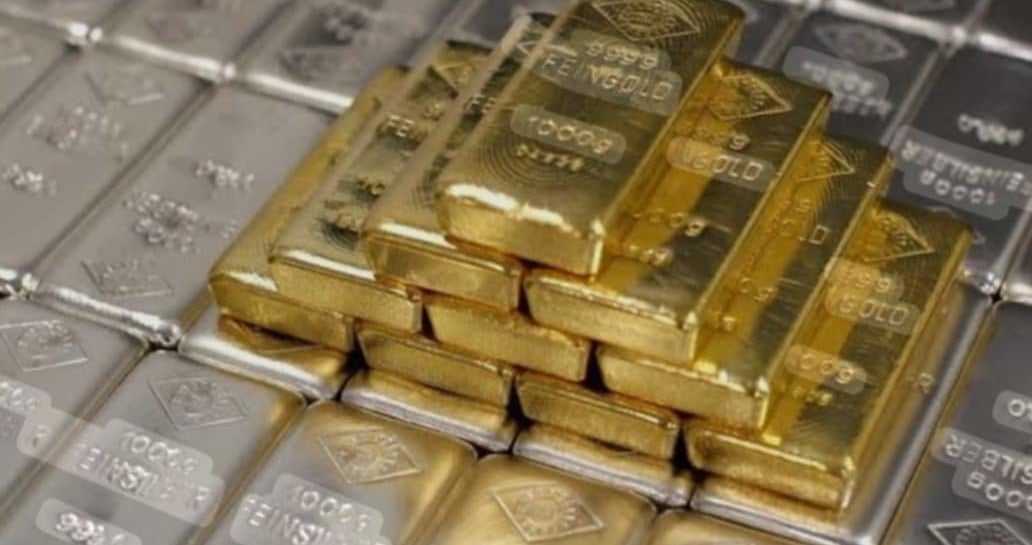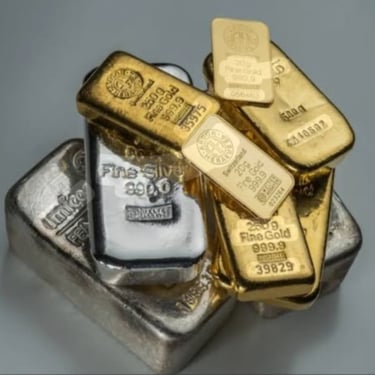Navigating Volatility: Understanding the Recent Moves in Gold and Silver
8/1/20256 min read


Navigating Volatility: Understanding the Recent Moves in Gold and Silver
The prices of gold and silver have been on a rollercoaster this week, with significant fluctuations driven by a mix of economic data, central bank policies, and global sentiment. While both metals are considered safe-haven assets, their individual dynamics and the current market environment are creating distinct movements.
Price Trends: A Tale of Two Metals
Recent data shows a mixed bag for precious metals. Gold prices have seen some heavy profit-taking and downward pressure, slipping to one-month lows in international markets. This is largely attributed to a stronger U.S. dollar and a reduction in safe-haven demand following a recent trade deal and robust U.S. economic data. On the other hand, while silver has also faced a sharp downturn in recent days, analysts suggest its long-term outlook may be more bullish due to its industrial applications.
Key Factors Driving Price Action
Several interconnected factors are influencing the current price movements in gold and silver:
U.S. Dollar Strength and Interest Rates: The U.S. Dollar Index (DXY) has been a major headwind for precious metals. When the dollar strengthens, it makes dollar-denominated commodities like gold and silver more expensive for holders of other currencies, dampening demand. A more hawkish stance from the Federal Reserve, which has held interest rates steady and signaled a cautious approach to future cuts, also makes non-yielding assets like gold less attractive compared to interest-bearing investments.
Safe-Haven Demand: Gold, in particular, thrives on global uncertainty. Geopolitical tensions, trade disputes, and economic instability often lead to a "flight to safety," where investors buy gold to preserve wealth. Recent progress on trade deals and generally strong U.S. economic indicators have reduced this risk-averse sentiment, leading to a decline in gold prices.
Industrial Demand: This is where silver's story diverges from gold's. While both are precious metals, silver has a significant industrial component, used in everything from solar panels and electric vehicles to electronics. A persistent supply-demand deficit, coupled with growing industrial usage, is a key structural driver that analysts believe could push silver prices higher in the medium to long term.
Futures Stocks and Trading Strategies
For investors and traders, the volatility in gold and silver presents both opportunities and risks. Here's a look at the landscape and some popular strategies:
Futures Contracts: Gold and silver futures contracts, traded on exchanges like the CME Group, allow investors to gain exposure to the metals without owning the physical asset. These contracts are leveraged, meaning a small amount of capital can control a large position. This offers potential for high returns but also carries significant risk.
Stocks: Investing in stocks of gold and silver mining companies or exchange-traded funds (ETFs) that track the price of the metals is another way to participate in the market. These can be subject to company-specific risks (for mining stocks) or tracking errors (for ETFs).
The Gold-Silver Ratio: A popular trading strategy involves using the gold-to-silver ratio, which measures how many ounces of silver it takes to buy one ounce of gold. When the ratio is high, it suggests silver is undervalued relative to gold, and some traders may sell gold to buy silver. Conversely, when the ratio is low, they might trade silver for gold. This "ratio trading" strategy is based on the idea that the ratio will revert to its long-term average.
Technical Analysis: Traders also use technical analysis, studying price charts, support and resistance levels, and other indicators to identify potential entry and exit points. Given the current volatility, many analysts are providing specific support and resistance levels for gold and silver, suggesting where prices might find a floor or a ceiling.
Looking Ahead: Volatility Expected to Continue
The outlook for gold and silver remains mixed, with volatility expected to persist. The price of gold will likely continue to be influenced by the Fed's monetary policy, the strength of the dollar, and any shifts in global risk sentiment. Silver's price, while sensitive to these same factors, has the added tailwind of strong and growing industrial demand, which could provide a solid foundation for future gains.

Precious metals, particularly gold and silver, have experienced a dynamic and volatile period, with prices fluctuating significantly this week. Here is a more detailed breakdown of the recent price movements, the factors driving them, and the strategies investors and traders are employing.
Recent Price Action and Analysis
Gold (XAU/USD): Gold prices have been on a roller coaster. After a brief rally last week, they have faced heavy selling pressure, slipping to a one-month low. This decline is largely due to a combination of profit-taking and a diminishing safe-haven appeal. Recent news, such as a new US-EU trade deal and generally strong U.S. economic data, has reduced the need for investors to hold gold as a hedge against risk. However, it's not a one-way street. Gold has found some support and is showing signs of a rebound, with prices now consolidating around the $3,300 per ounce level. Some analysts believe that while there may be short-term pressure, the long-term outlook for gold remains bullish, with some even forecasting prices to rise toward $4,000 by mid-2026. This long-term view is supported by continued central bank purchases and a strong demand from investors seeking a hedge against inflation and policy risks.
Silver (XAG/USD): Silver has followed gold's lead to some extent, also seeing a sharp downturn. However, its trajectory is influenced by its dual role as both a precious metal and an industrial commodity. While it has been hit by the same factors as gold—a stronger dollar and reduced safe-haven demand—its industrial applications, particularly in solar panels and electric vehicles, are providing a structural floor. Despite a recent correction, some analysts believe silver is currently undervalued, especially when looking at the gold-to-silver ratio, which shows how many ounces of silver it takes to buy one ounce of gold. A high ratio suggests that silver has more room to rally relative to gold.
Driving Forces: The Macro Picture
U.S. Monetary Policy and the Dollar: The Federal Reserve's policy decisions are a central influence. The Fed's continued stance of holding interest rates steady and its cautious tone on future rate cuts have bolstered the U.S. dollar. A stronger dollar makes dollar-denominated assets like gold and silver more expensive for international buyers, which can suppress demand and prices. The market is now closely watching for any signals from the Fed about a potential rate cut, as a dovish shift could weaken the dollar and provide a significant boost to precious metals.
Global Geopolitics and Trade Tensions: While recent trade deals have temporarily eased concerns, new tariff announcements have reintroduced an element of risk into the market. Geopolitical uncertainty often drives a "flight to safety," and both gold and silver benefit from this. The current environment is a tug-of-war between positive economic data and lingering trade-related risks. Any escalation of trade tensions could quickly reverse the recent downturn in precious metals prices.
Central Bank Demand: A significant long-term driver for gold prices is the consistent purchasing by global central banks. The World Gold Council reported that total gold demand, including over-the-counter trades, rose in Q2 2025, with central banks being a key source of demand. This ongoing accumulation of gold reserves provides a solid foundation for the metal's price and is a key factor supporting a bullish long-term outlook.
Futures, Stocks, and Strategies
Futures Trading: The gold and silver markets are heavily influenced by futures trading on exchanges like the CME Group. Traders are currently adopting a mix of strategies. Some are using a "Sell on Rise" approach for gold, targeting specific resistance levels around $3,355 per ounce on the COMEX, as technical indicators suggest a weak rebound. Others are waiting for a clear breakout above these resistance levels before re-entering the market.
Mining Stocks and ETFs: Investing in the stocks of gold and silver mining companies or in precious metals-backed ETFs is another common approach. Mining stocks can offer leveraged exposure to the price of the metal, meaning their value can rise or fall more dramatically than the underlying commodity. However, they also carry company-specific risks. ETFs, such as those that track the physical price of gold and silver, offer a more direct way to invest.
Ratio Trading: The gold-to-silver ratio is a key tool for many traders. When the ratio is high (meaning silver is cheap relative to gold), some investors might sell gold and buy silver, anticipating that the ratio will revert to its historical average. This strategy is based on the idea that both metals are correlated, but silver's industrial demand can make it more volatile and prone to bigger swings. Given silver's recent underperformance relative to gold, some analysts see a compelling case for a silver play from a two-to-three-year perspective.
In summary, the current precious metals market is a complex environment where short-term negative factors like a strong dollar and reduced safe-haven demand are clashing with long-term bullish drivers like industrial demand (for silver) and consistent central bank buying (for gold). For investors, careful monitoring of key economic indicators, central bank policies, and technical price levels is crucial.
